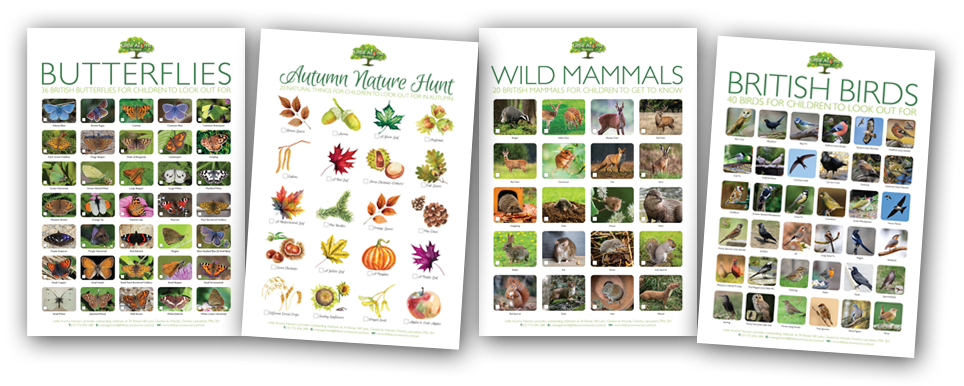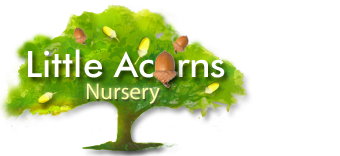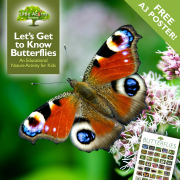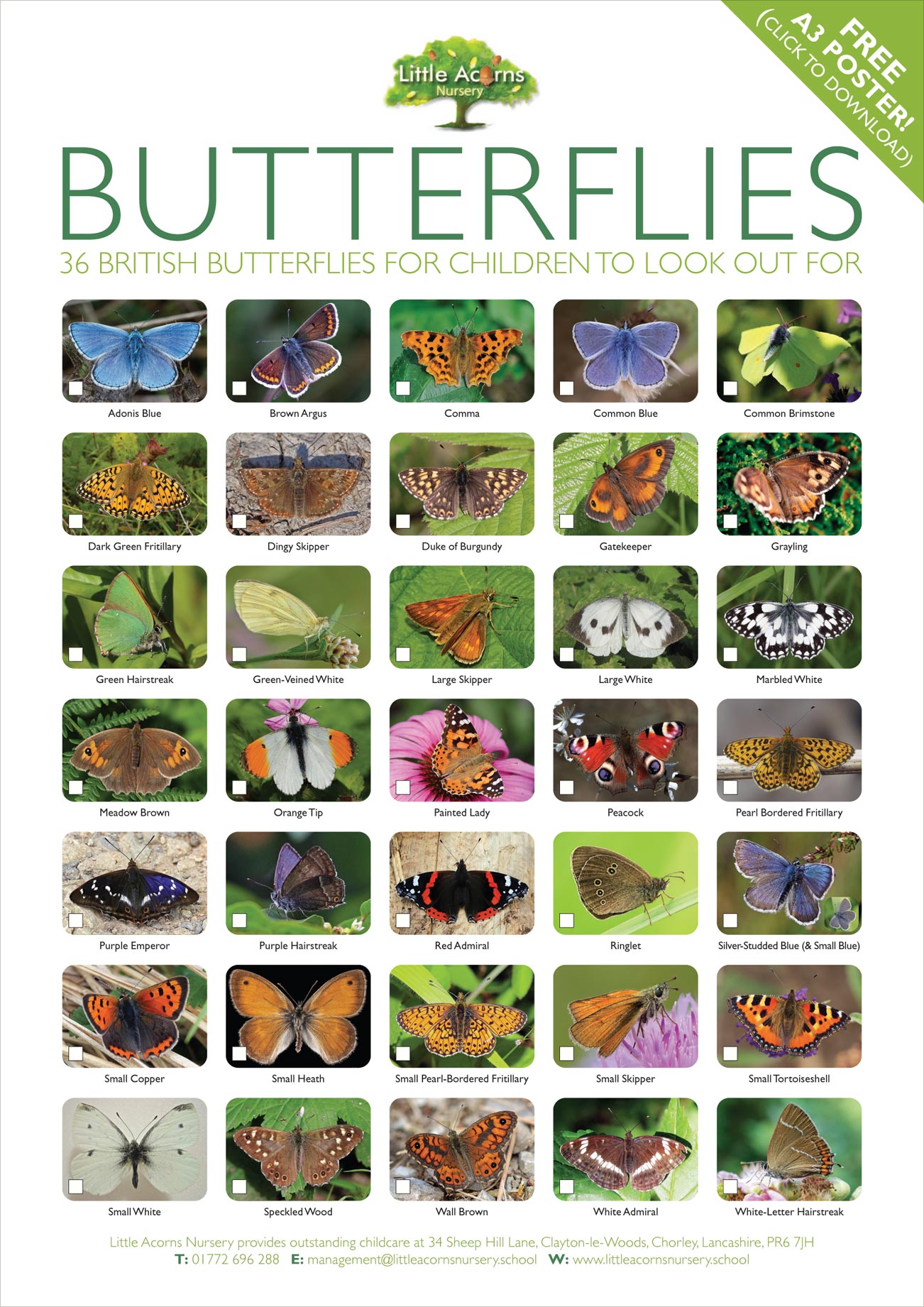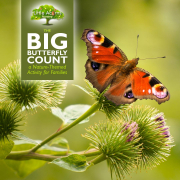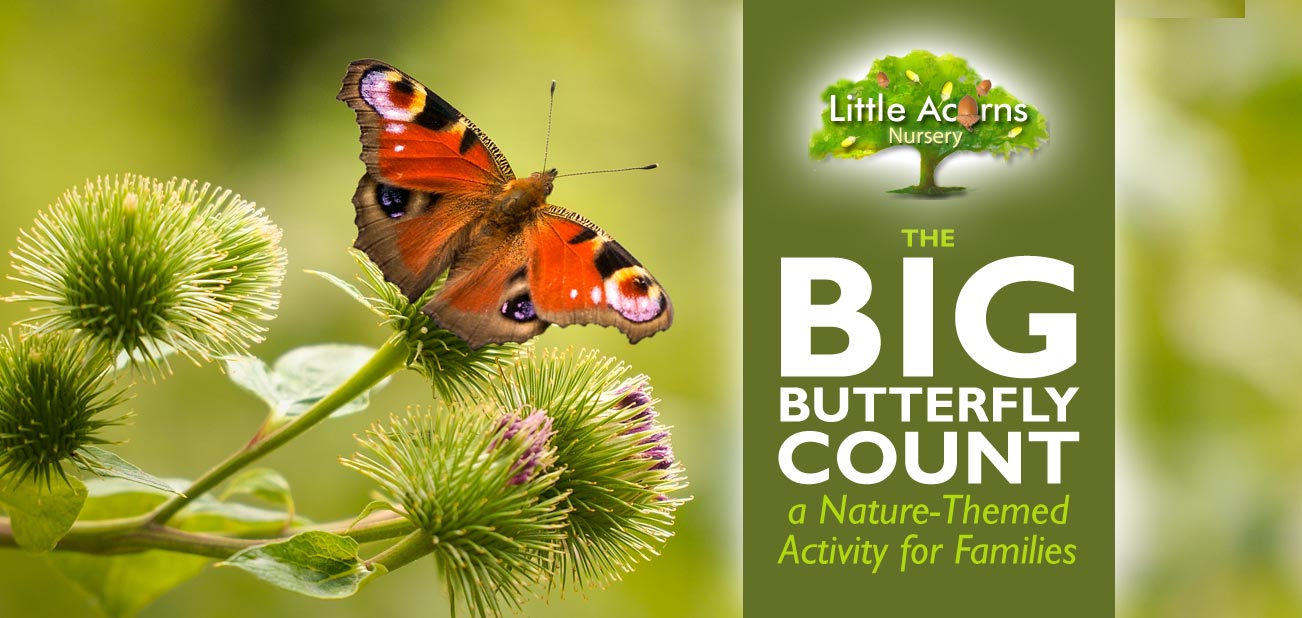
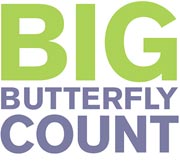 Many will have heard of the Big Garden Birdwatch that takes place every year in January. However, fewer are aware of a similar activity called The Big Butterfly Count that takes place in July and early August. As well as being extremely worthwhile, it’s a wonderful activity for both children and adults to get involved in as citizen scientists. The activity helps with butterfly conservation, is educational for those taking part, and encourages families to get outdoors, closer to nature. And, as we know, getting closer to nature is very good for children and people of all ages. Today, we take a look at this wonderful butterfly-spotting activity and explain how children and families can get involved, help these beautiful little pollinators, contribute a little time to the conservation initiative and benefit themselves at the same time.
Many will have heard of the Big Garden Birdwatch that takes place every year in January. However, fewer are aware of a similar activity called The Big Butterfly Count that takes place in July and early August. As well as being extremely worthwhile, it’s a wonderful activity for both children and adults to get involved in as citizen scientists. The activity helps with butterfly conservation, is educational for those taking part, and encourages families to get outdoors, closer to nature. And, as we know, getting closer to nature is very good for children and people of all ages. Today, we take a look at this wonderful butterfly-spotting activity and explain how children and families can get involved, help these beautiful little pollinators, contribute a little time to the conservation initiative and benefit themselves at the same time.
The Big Butterfly Count
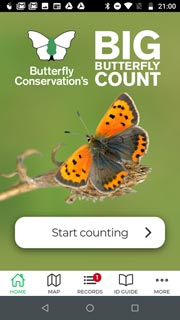 Organised by the charity Butterfly Conservation, the long-term aim of the Big Butterfly Count is for butterflies and moths to thrive and be enjoyed by everyone. That’s important because populations of butterflies have really suffered in recent decades, with some species of butterfly even becoming extinct in the UK and elsewhere. Changes in their numbers are also very good indicators of wider problems in pollinators of all types, including bees for example.
Organised by the charity Butterfly Conservation, the long-term aim of the Big Butterfly Count is for butterflies and moths to thrive and be enjoyed by everyone. That’s important because populations of butterflies have really suffered in recent decades, with some species of butterfly even becoming extinct in the UK and elsewhere. Changes in their numbers are also very good indicators of wider problems in pollinators of all types, including bees for example.
The key requirement of the Big Butterfly Count is simply for families across the UK to spend just a little time outdoors, during a very specific time of the year, to record how many different species they see during that time. The findings of thousands of families throughout the UK will then help Butterfly Conservation to understand what species are living in the different UK regions. Data submitted will allow a comparison of reported data from year to year, so Butterfly Conservation can see trends in butterfly populations and spot any significant increases, reductions and areas of concern.
“Help take the pulse of nature.”
When is the Big Butterfly Count?
For 2024, the Big Butterfly Count is any daylight time from Friday 12th July to Sunday 4th August. The reason this period is chosen is because that’s when most butterflies have reached adulthood, so people should be able to spot more of them. This ‘peak adult’ period is essentially at the same approximate period every year.
How Can Families Get Involved?
Getting involved in the Big Butterfly Count is easy and takes very little time. All that’s needed is a 15-minute period of time during daylight hours, between 12th July and 4th August. Bright, sunny weather conditions are preferred. Families simply need to find a good spot* outdoors and watch carefully, just for a quarter of an hour, and record which types of butterflies they spot. They can then submit their sightings any time up until 31 August. The count focuses on specific species within each area of the UK. These are mainly butterflies but they also include a few daytime-flying moths that Butterfly Conservation are interested in monitoring.
*Another alternative, by the way, is for children and families to monitor butterflies during a 15-minute walk i.e. you do not necessarily have to stay in one spot.
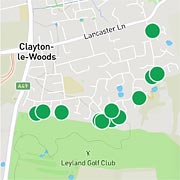 If you are counting butterflies from a static spot, count up how many of the same species you see at the same time. For example, if there are three Large Whites visible at the same time, count that as three. If you see only one at a time, but see it on three separate occasions during the 15 minutes, that counts as only one. That’s so that we can be sure it’s not the same one visiting three times!
If you are counting butterflies from a static spot, count up how many of the same species you see at the same time. For example, if there are three Large Whites visible at the same time, count that as three. If you see only one at a time, but see it on three separate occasions during the 15 minutes, that counts as only one. That’s so that we can be sure it’s not the same one visiting three times!- If you’re counting while on a walk, however, simply count the number of each species you see during the entire 15-minute time frame.
- You may do as many counts as you like; then simply submit the separate records, through the app, for each different location and/or date.
- As well as having a section for your own submissions, an interactive map can be found on the smartphone app to show you results from other people across the entire UK. Zoom in for more detail. Shown in the image is the butterfly counts for 2022 in Clayton-le-Woods. In the app itself, each is clickable so you can find out which species were spotted and the number of them.
Where is a Good Spot to See Butterflies?
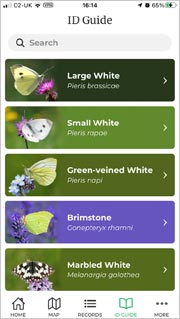 A good spot, by the way, would be either somewhere outdoors with lots of flowers to attract butterflies and other pollinators, or somewhere you’ve left out some very ripe fruit e.g. pieces of ripe orange, apple, nectarine, grapefruit, banana, or strawberry— butterflies love sweet fruit even when it’s a little over-ripe! Whether that’s in your own garden, near potted flowers on a patio, school grounds, in a park, or out in the countryside is entirely up to you and your family. Even if you spot no butterflies during your 15-minute count, you should still submit your results, by the way, as that might indicate a problem with the butterfly population — and potentially other types of wildlife loss — in that area.
A good spot, by the way, would be either somewhere outdoors with lots of flowers to attract butterflies and other pollinators, or somewhere you’ve left out some very ripe fruit e.g. pieces of ripe orange, apple, nectarine, grapefruit, banana, or strawberry— butterflies love sweet fruit even when it’s a little over-ripe! Whether that’s in your own garden, near potted flowers on a patio, school grounds, in a park, or out in the countryside is entirely up to you and your family. Even if you spot no butterflies during your 15-minute count, you should still submit your results, by the way, as that might indicate a problem with the butterfly population — and potentially other types of wildlife loss — in that area.
“Numbers of butterflies and moths in the UK have decreased significantly since the 1970s. This is a warning that cannot be ignored.”
How Can You Identify the Types of Butterflies?
Help is on hand to help children/families more easily identify which butterfly species they spot on the day — and at any other time. On the day, families with smartphones can use the free Big Butterfly Count phone app, which is available on both Apple IOS and Android. Below are the links to download them, free of charge, and they seem pretty fast to download too.


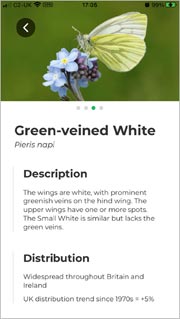 For the youngest of children, an adult will need to supervise the use of the app but many older children will no doubt take to the technology like ducks to water. The app includes several sections including an excellent guide to up to about 21 species that the Big Butterfly Count is particularly interested in this year. Shown are details about each type along with photographs for reference and ID purposes. Details of each type of butterfly — or daytime-flying moth — include information like the difference between males and females, their distribution in the UK, and whether their populations have increased or decreased. Photos show each type with wings both open and closed, making identification even easier.
For the youngest of children, an adult will need to supervise the use of the app but many older children will no doubt take to the technology like ducks to water. The app includes several sections including an excellent guide to up to about 21 species that the Big Butterfly Count is particularly interested in this year. Shown are details about each type along with photographs for reference and ID purposes. Details of each type of butterfly — or daytime-flying moth — include information like the difference between males and females, their distribution in the UK, and whether their populations have increased or decreased. Photos show each type with wings both open and closed, making identification even easier.
What if you Spot a Butterfly Species You Can’t Identify?
If you happen to spot a butterfly that’s not included in the species of interest shown in the Big Butterfly Count phone app for your area, you can instead submit them using the free iRecord Butterflies app, details of which are available here. That alternative app can be used any time of year and features many more types of butterflies and moths. It still, however, allows you to submit your sightings to help with conservation and monitoring efforts. Indeed, you could argue that it’s a more permanent way of children helping to both monitor and report butterfly sightings as little citizen scientists.
What If You Don’t Have a Smartphone?
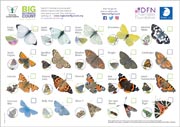 You/your child can still get involved in the Big Butterfly Count even if you/they don’t have a smartphone. Instead of using an app, download charts of the butterflies in your area from the Big Butterfly Count website. You’ll need to fill in a very short form to access the chart links, but they are free of charge and obligation. Choose the most appropriate download link for your region and download the chart. You/your child can then view it on screen and zoom in for the best detail, or print it out on paper. Once you’ve ticked off any that you/your child have seen in the 15-minute period, you will need to ask a friend or family member who has the app if you want them to submit your count for you, however. That’s because paper, email and phone submissions cannot be accepted. Spotting butterflies is a wonderful activity for children, though, whether or not their results are submitted.
You/your child can still get involved in the Big Butterfly Count even if you/they don’t have a smartphone. Instead of using an app, download charts of the butterflies in your area from the Big Butterfly Count website. You’ll need to fill in a very short form to access the chart links, but they are free of charge and obligation. Choose the most appropriate download link for your region and download the chart. You/your child can then view it on screen and zoom in for the best detail, or print it out on paper. Once you’ve ticked off any that you/your child have seen in the 15-minute period, you will need to ask a friend or family member who has the app if you want them to submit your count for you, however. That’s because paper, email and phone submissions cannot be accepted. Spotting butterflies is a wonderful activity for children, though, whether or not their results are submitted.
Safety & Well-Being of Children & Butterflies
Safety is paramount, of course, so young children should be accompanied and supervised by a responsible adult. It’s also important, of course, not to disturb or interfere with the butterflies. They are extremely delicate little creatures and their wings and bodies are too fragile for handling. Please do not try to catch them — you will do more harm than good.
“Butterfly declines are also an early warning for other wildlife losses … if their numbers are falling, then nature is in trouble. That’s why taking part in this massive citizen science enterprise is of great importance.”
A Focus on Nature at our Outstanding Nursery/Preschool in Clayton-le-Woods, Chorley

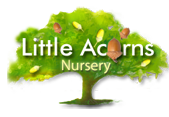
At Little Acorns Nursery, we know how important it is to get children involved with nature, so will always encourage worthwhile, educational activities like this one. As a Forest School setting, we encourage them to appreciate the natural world and all the flora and fauna within it, so this butterfly-spotting activity is a perfect fit. We also encourage children elsewhere and at home to get involved — it’ll do them, their families, butterflies and the natural environment great good.
Ofsted rate Little Acorns Nursery as an outstanding nursery/preschool in Clayton-le-Woods, and we’re also the winner of a National Nursery award. It simply doesn’t get any better than that and you therefore know your baby, toddler or child under five will be in good hands at Little Acorns. All Government childcare funding schemes are also supported for eligible families. To register your child for a place or to enquire about the possibility, please choose an option below:
Although Little Acorns is located in Clayton-le-Woods, Chorley, in Central Lancashire, we will also be a convenient option for those looking for high-quality childcare near Clayton Brook, Clayton Green, Thorpe Green, Pippin Street, Buckshaw Village, Whittle-le-Woods, Farington, Bamber Bridge, Lostock Hall, Euxton, Leyland and Penwortham.
Quotations in this article are from Butterfly Conservation.
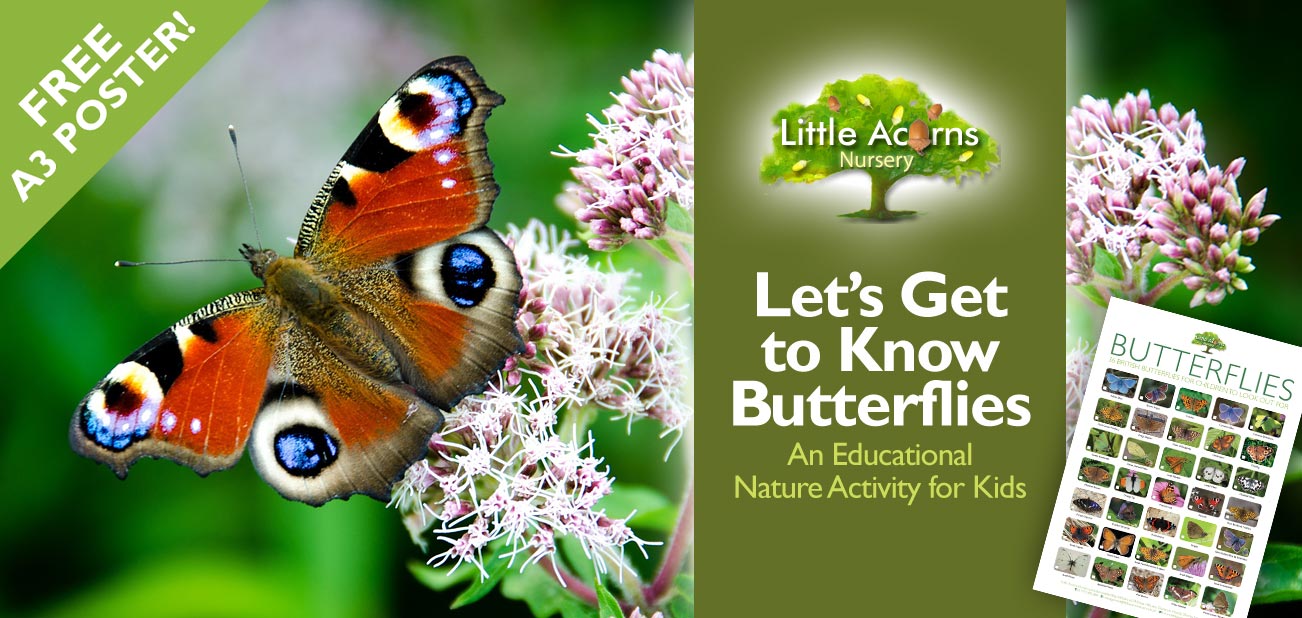
 For many species, population numbers have plummeted over recent decades. Introducing your child to today’s butterfly spotting activity and the annual Big Butterfly Count are therefore very simple ways to get them interested in nature and the importance of looking after the natural environment. They are also more likely to go on to have more sustainable lifestyles when they spend time in and around nature during early childhood. That’s crucially important because today’s children will become tomorrow’s guardians of our beautiful planet — and it will need to be looked after well.
For many species, population numbers have plummeted over recent decades. Introducing your child to today’s butterfly spotting activity and the annual Big Butterfly Count are therefore very simple ways to get them interested in nature and the importance of looking after the natural environment. They are also more likely to go on to have more sustainable lifestyles when they spend time in and around nature during early childhood. That’s crucially important because today’s children will become tomorrow’s guardians of our beautiful planet — and it will need to be looked after well.